A guide to Brest Fortress – what there is to see and a little history
I’ve just finished watching Fortress of War, a 2010 war film jointly produced by Russian and Belarusian filmmakers and directed by Aleksander Kott. Set entirely within the grounds of the fortress in Brest, a medium-sized city on the Belarusian/Polish border, the film focuses on its defence against the German Wehrmacht during the very early stages of Operation Barbarossa in World War II.
The film follows the story of a regiment commander, a lieutenant and a political commissar, all of whom are in the Red Army, as they and their soldiers struggle and ultimately fail to hold back the far superior and better equipped German forces. Told through the eyes of 15-year-old Sasha Akimov, a military cadet and bugler, the production has been praised for its historical accuracy and rated highly by film critics.
My main interest in seeing the movie was because Kirsty and I visited Belarus earlier this year (May 2016) as part of our summer travels through Eastern Europe and Central Asia and we spent a couple of nights in Brest. Our visit to the fortress left us in awe and I’ll explain why in due course but before I do that, let me state a few facts about the fortress and summarise the events that led to its defence and ultimate destruction in June 1941.
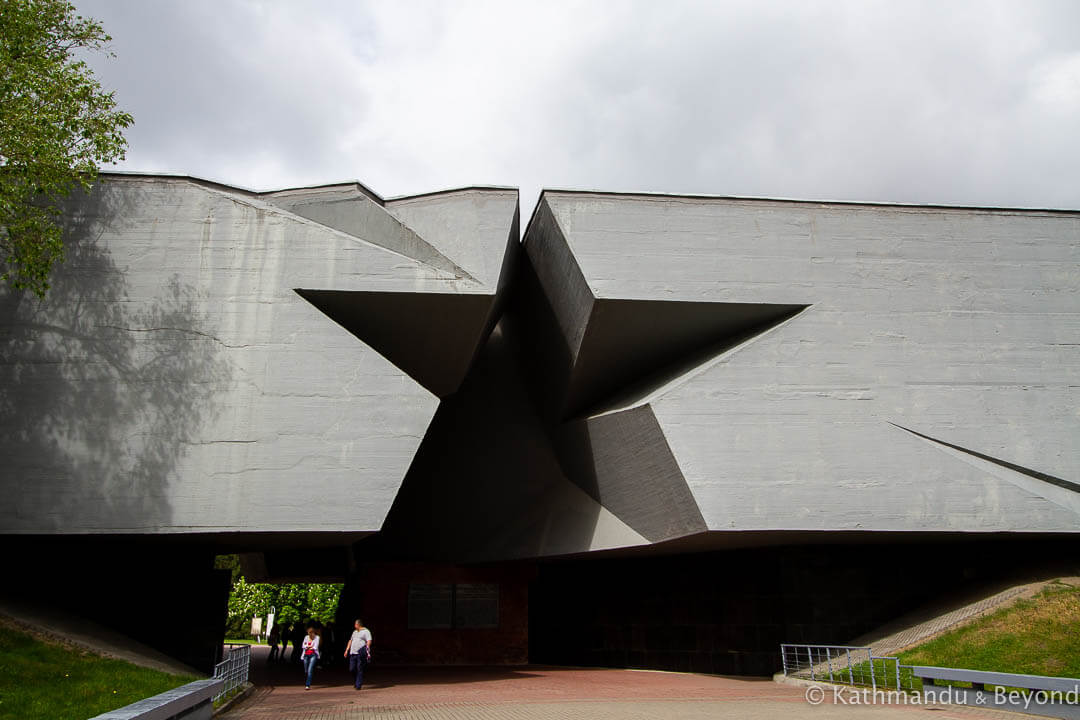
Main entrance, Brest Fortress
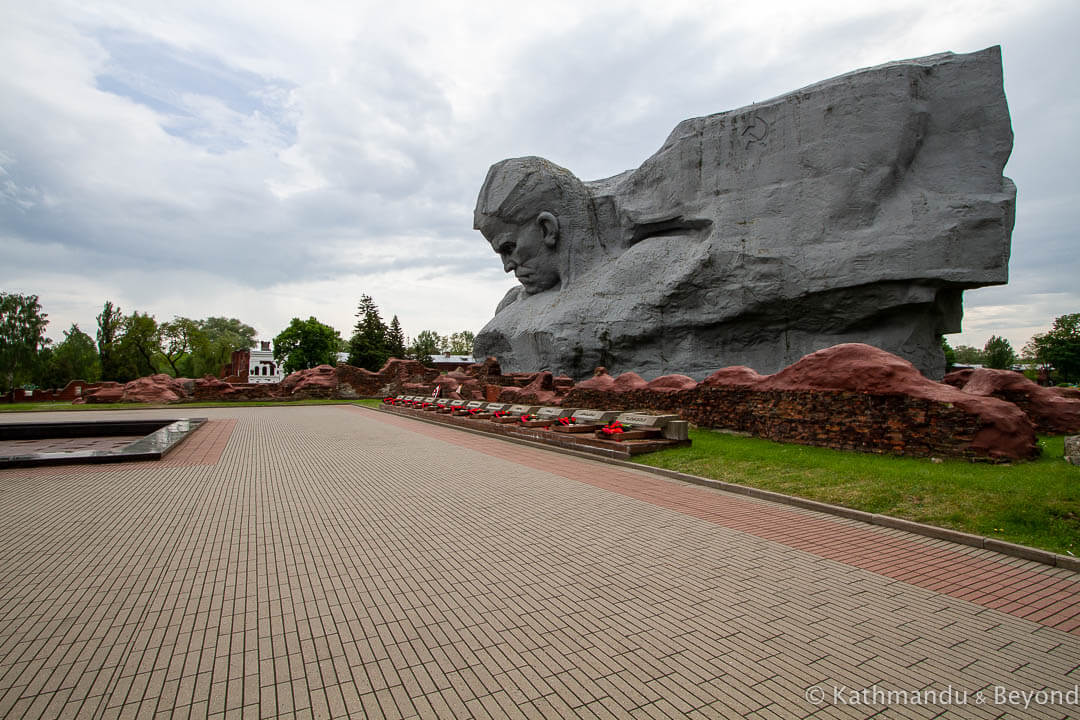
Valour, Brest Fortress
A brief history of the Brest Fortress and its defence during World War II
Brest Fortress is a 19th-century Russian citadel, strategically located on an island surrounded by the Bug River and two branches of the Mukhavets River. During World War II, the Germans launched their attack on the fortress on 22nd June 1941 and finally captured it seven days later on the 29th June. It was the first battle of Operation Barbarossa, the code word used by the Nazis for their all-out attack on the Soviet Union. The battle was, in fact, a recapturing of the fort, as the Germans had already taken it once during World War II. The first time was from the Polish in September 1939, but due to their non-aggression pact with Russia at the time, they were forced to hand it over to the Soviets.
There were approximately 9,000 Soviet troops inside the fortress as well as 300 families of the servicemen. In comparison, the number of Wehrmacht soldiers totalled about 20,000 men, of which the majority were Austrian. Initial shelling began very early on the morning of the 22nd June and the Red Army was taken totally by surprise (*).
(*) It is questionable whether they even suspected an attack given Russia had signed a non-aggression pact with the Nazis in August 1939.
Within half an hour of the initial artillery bombardment, German troops were pouring into the fortress and inflicting heavy casualties on the Soviets. So quick was the element of surprise that the Red Army didn’t have time to form a united line of fortification and instead were forced to defend isolated pockets of the fortress. Stunned, outnumbered, trapped and short of supplies (including drinking water), the Soviet soldiers still managed to hold out for several more days as well as inflict heavy casualties on the Germans. But, to add misery to woe, they were also cut off from the rest of the Soviet Union and reinforcement were never sent. The Luftwaffe bombed the fortress on the last day of the siege and the Soviets were forced to capitulate.
Both the city of Brest and the fortress were eventually liberated by the Red Army in July 1944.
Several posthumous Hero of the Soviet Union medals (the highest distinction possible) were awarded for personal or collective feats of bravery during the siege and the fortress itself was reconstructed during the course of the 1960s and turned into a World War II memorial and place of homage for the Belarusian people.
After several years of reconstruction and restoration as well as the building of new monuments, Brest Hero-Fortress, as it was renamed, was officially opened on 25 September 1971. More than 600 veterans from the campaign attended the opening ceremony.
During the construction, workers found numerous artefacts from the period as well as the remains of many hundreds of soldiers and civilians who perished during the defence of the fortress. According to the fortress’s official website (see further reading below), 823 bodies were dug up (*) and reburied with honours within the grounds.
(*) It’s interesting to ponder whether, given the heavy casualties incurred by the Wehrmacht, if any of those reburied were, in fact, German soldiers?
What is there to see at the Brest Fortress Memorial Complex?
I want to start by saying that the Brest Fortress Memorial Complex is THE most impressive Socialist-era monument I have seen to date. The sheer scale is incredible and I was like the kid in a candy store and Kirsty and I wandered around for a good couple of hours with the camera clicking ten to the dozen.
The first monument to give you a whoa! moment is the entrance itself – an imposing five-pointed star, which is carved into a reinforced concrete block and symbolises military honour. The walk from the main road gives you plenty of time to appreciate its magnitude. As you get closer, the austere Soviet war song ‘Holy War’ (composed in 1941 by Alexander Aleksandrov (music) and Vasilii Lebedev-Kumach (lyrics)), along with an archive propaganda message about Nazi Germany’s attack on the Soviet Union (read by Yuri Levitan, who was the primary radio announcer in the Soviet Union during and after World War II) pipe out as you head through the tunnel to the fortress proper. Occasionally, the music and announcement are interrupted by sound effects such as aerial bombardment, machine-gun fire and aircraft dive-bombing.
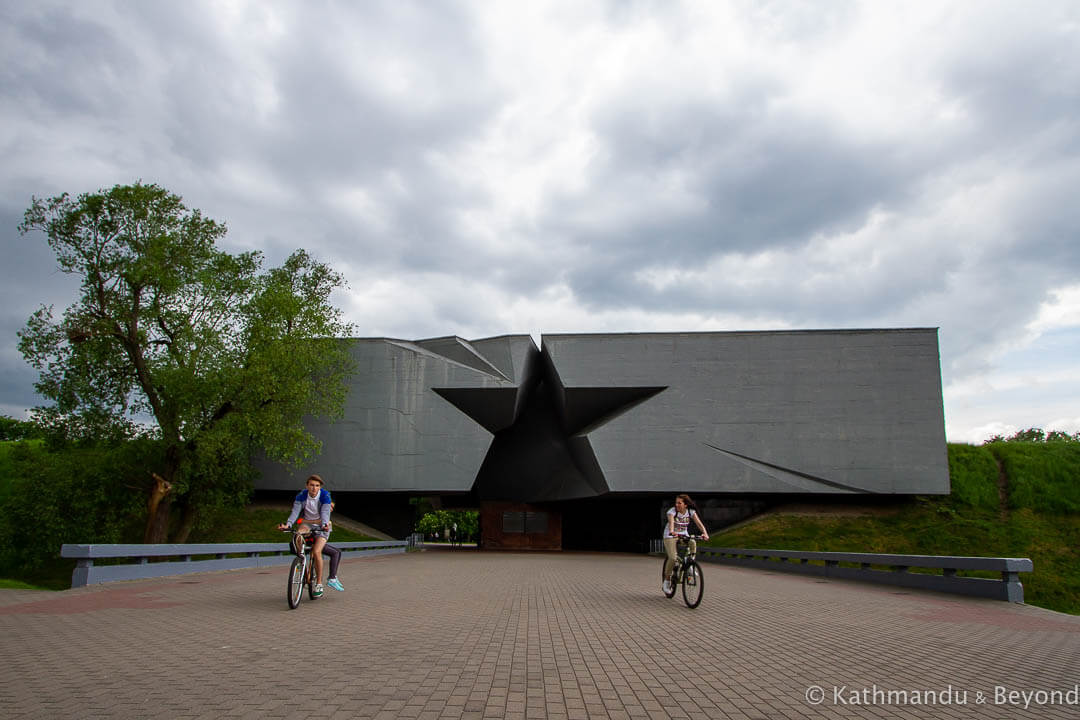
Main entrance, Brest Fortress
It sets the scene and puts you in a suitably sombre mode for what is to come. It’s a pleasant 10-minute stroll from the entrance to the centre of the complex, which is officially known as Ceremonial Square. There are a few tanks on the left-hand side as you approach the square plus an area where you can dress up in period military uniforms and have your photo taken if that’s your thing. This is the only part of the complex which shows any hint of tackiness.
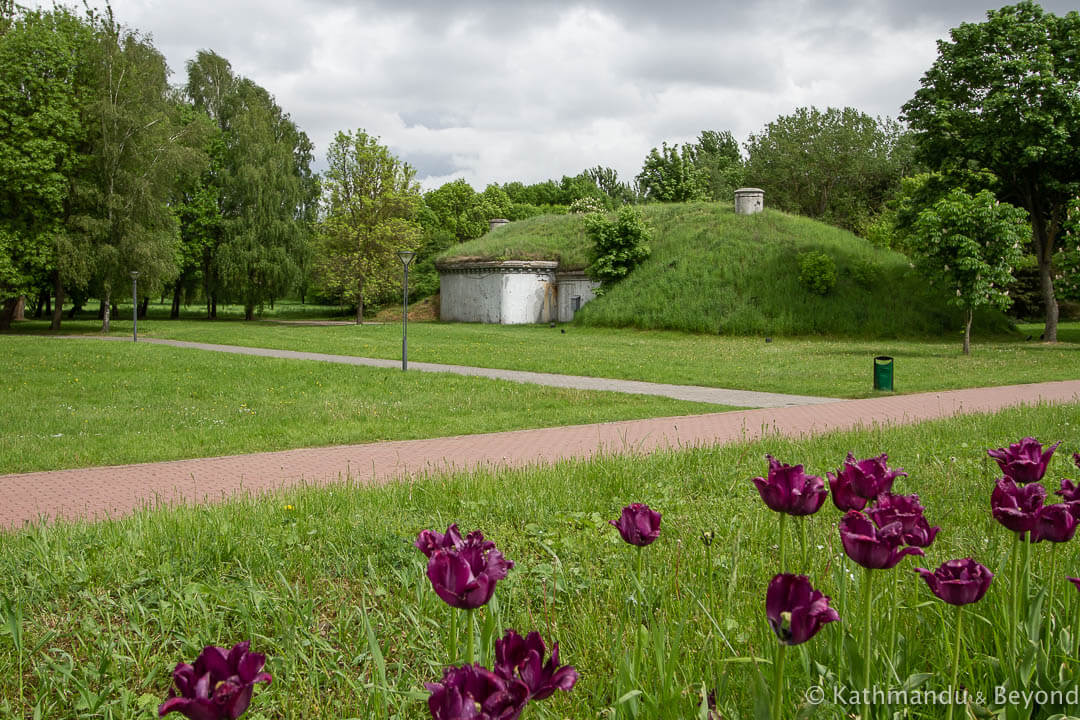
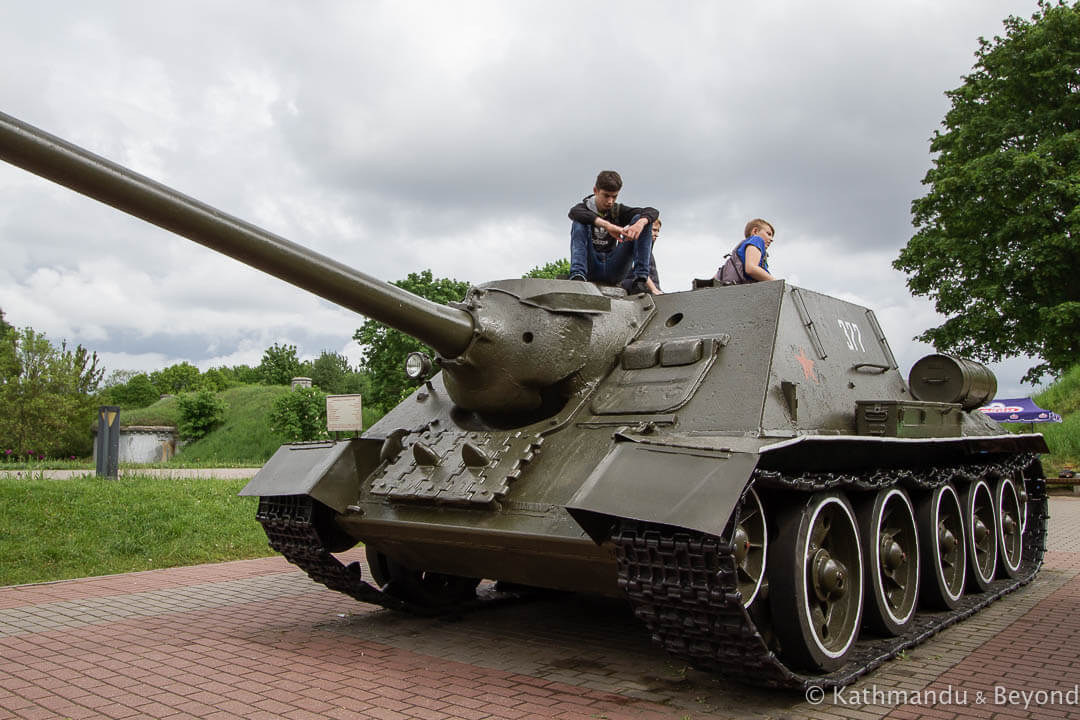
The first statue you see as you enter Ceremonial Square is Thirst. The fortress’s water supply system was destroyed by enemy gunfire on the first day of the invasion and not only was water needed for drinking, but it was also essential for cooling the guns. Many Red Army soldiers risked and lost their lives running the gauntlet to the nearby river and Thirst depicts a soldier crawling to the riverbank with a helmet in his hand. It’s powerful and dramatic but pales somewhat as soon as you clap eyes on Valour.
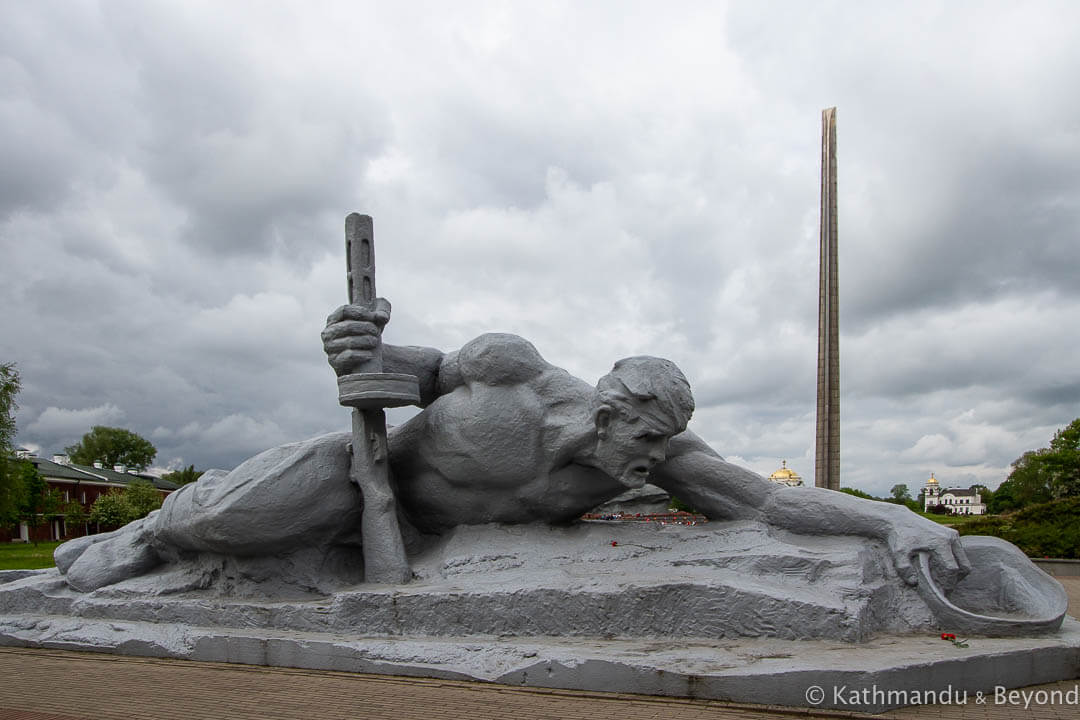
Thirst, Brest Fortress
Overlooking the memorial burial ground (where the remains of the 823 bodies are now buried), stands a 100-metre-high titanium-coated bayonet obelisk and the eternal flame. Beneath the obelisk and dominating the scene is the gargantuan monument Valour, 30 metres high and 54 metres in width and depicting the head of a Soviet soldier. Although it gives the appearance of being carved out of one almighty large piece of stone, Valour is in fact made up of two hundred individual concrete parts and is hollow inside. The bas-relief on the back of the monument portrays notable acts of courage during the defence of the fortress.
For me personally, it was stunning; a beautiful piece of art and I was totally mesmerised by it. It was also fitting that we visited on a suitably dark and miserable day.
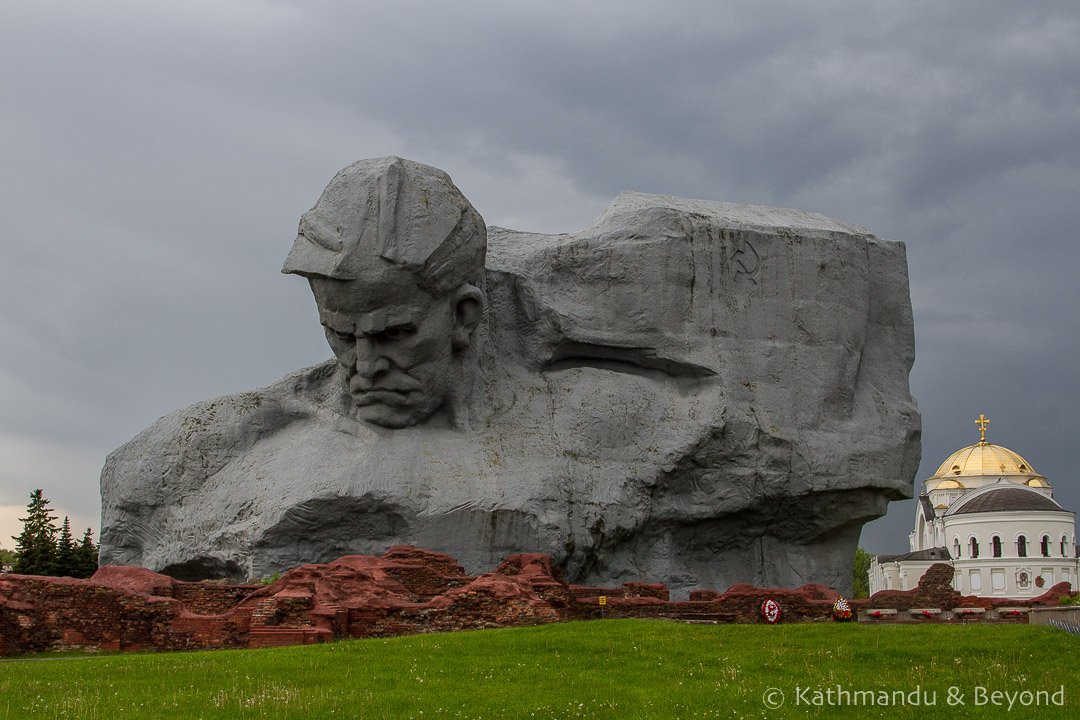
Valour, Brest Fortress
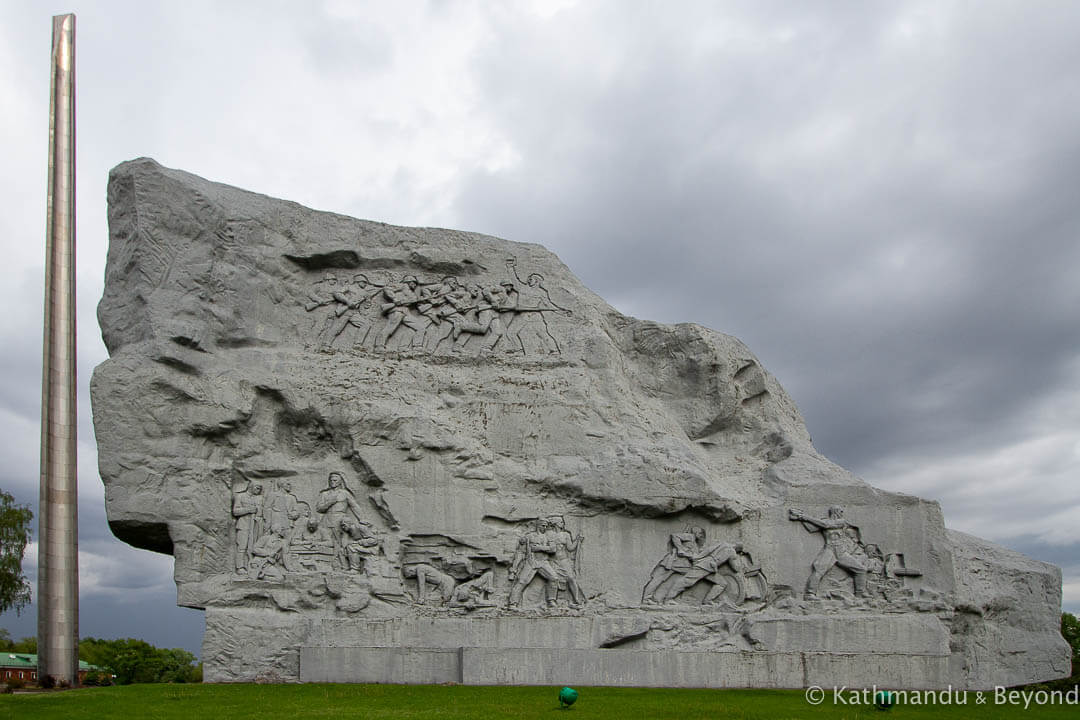
The backside of Valour, Brest Fortress
Nearby Nikalaivsky (Nicholas) Church, which is dwarfed by Valour, housed the soldier’s club prior to the eve of the battle and remained one of the last pockets of resistance during the campaign. It was kept as a memorial for several decades after World War II and eventually returned to the Orthodox Church in 1994, which is when restoration work began. The church holds regular services nowadays and is the oldest place of worship in the city of Brest.
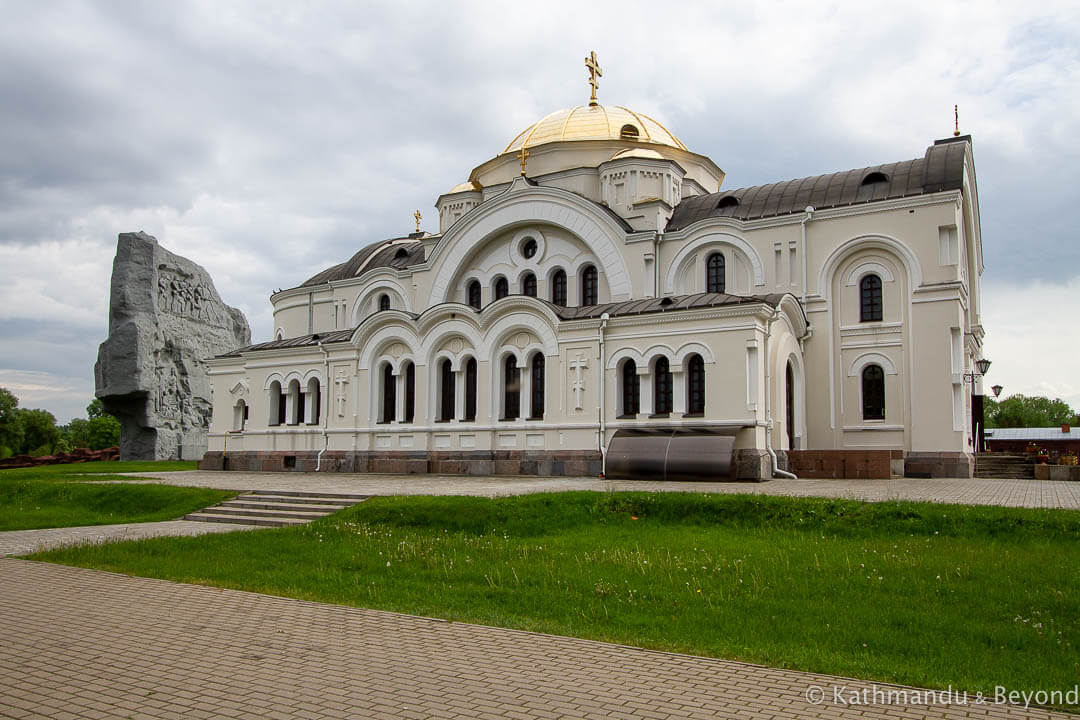
Nikalaivsky (Nicholas) Church, Brest Fortress
There are other places of interest within the grounds of the citadel. Kholmskie Gate, for example, played a key role in the defence of Brest and is still riddled with hundreds of shrapnel and bullet holes on the outside of the building. There are also a couple of museums within the grounds. The main one is the Brest Fortress Defence Museum, which is located in a restored part of the barracks and details the plight of the defenders. We didn’t go in this or any of the museums during our visit as the displays were predominantly in Belarusian and Russian plus there were a ton of school kids running riot when we were there and we didn’t fancy our chances of looking around in peace and quiet.
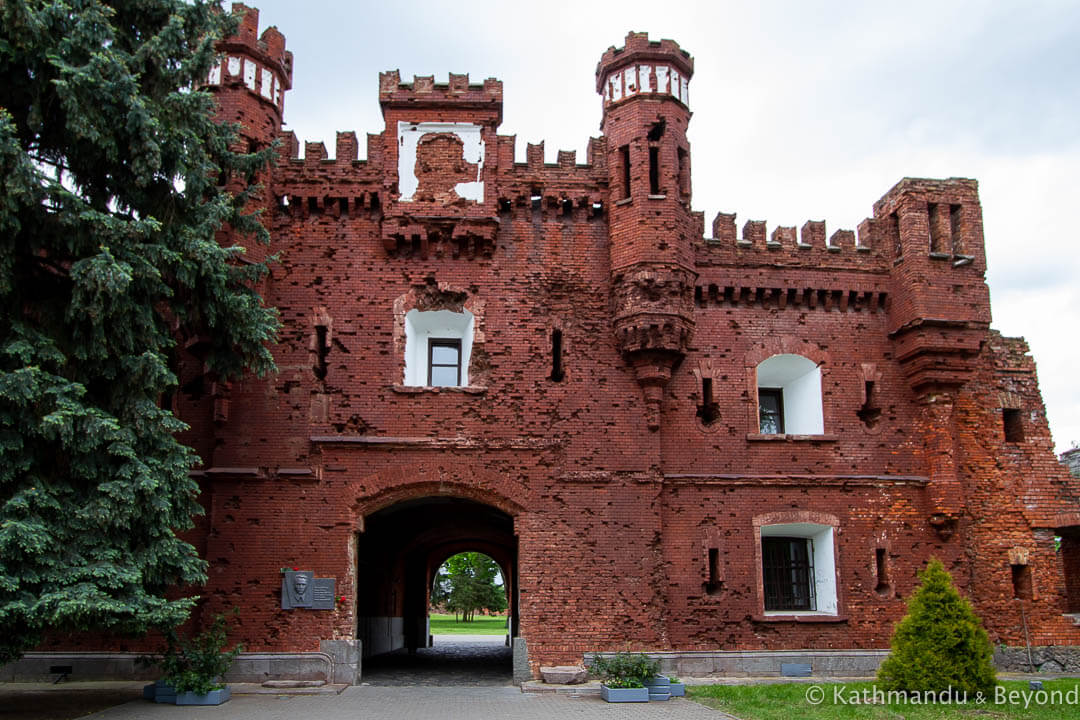
Kholmskie Gate, Brest Fortress
We did wander around parts of the grounds away from Ceremonial Square, however, which was worth doing as we came across disused barracks and other such remnants.
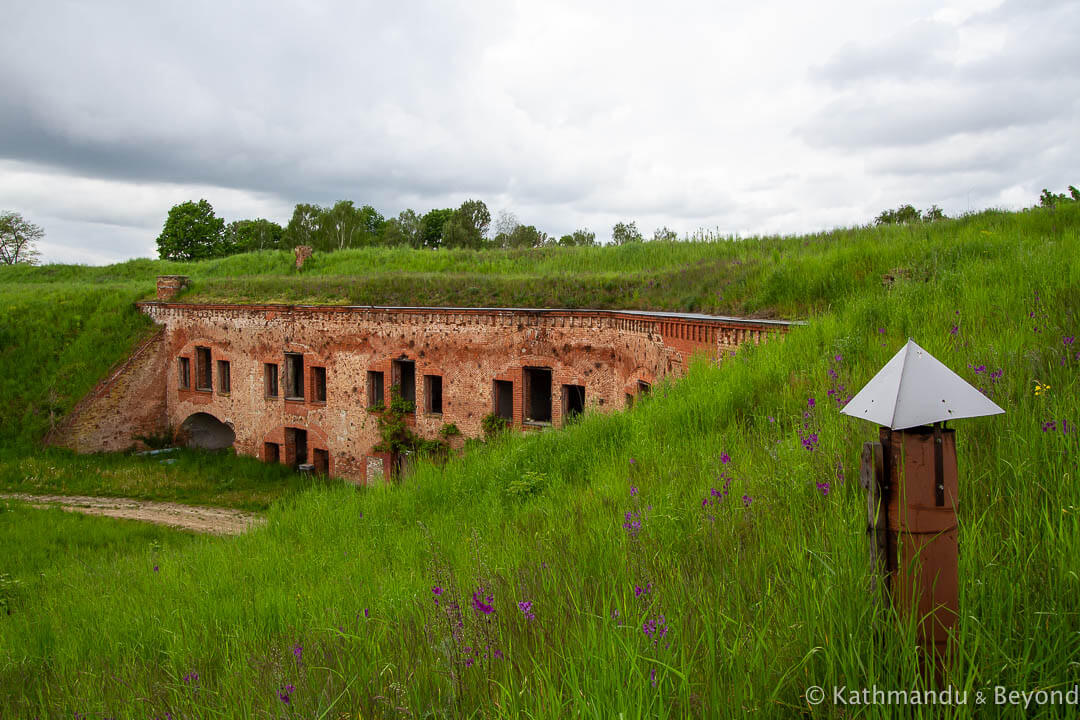
We took about two hours to look around the complex in total. To the best of our knowledge, we were the only foreign tourists there but, as the fortress is a place of national heritage, it was pretty busy with locals including families, military cadets and groups of schoolchildren. The verdant grounds are also a popular spot for wedding photos, even in the rain!
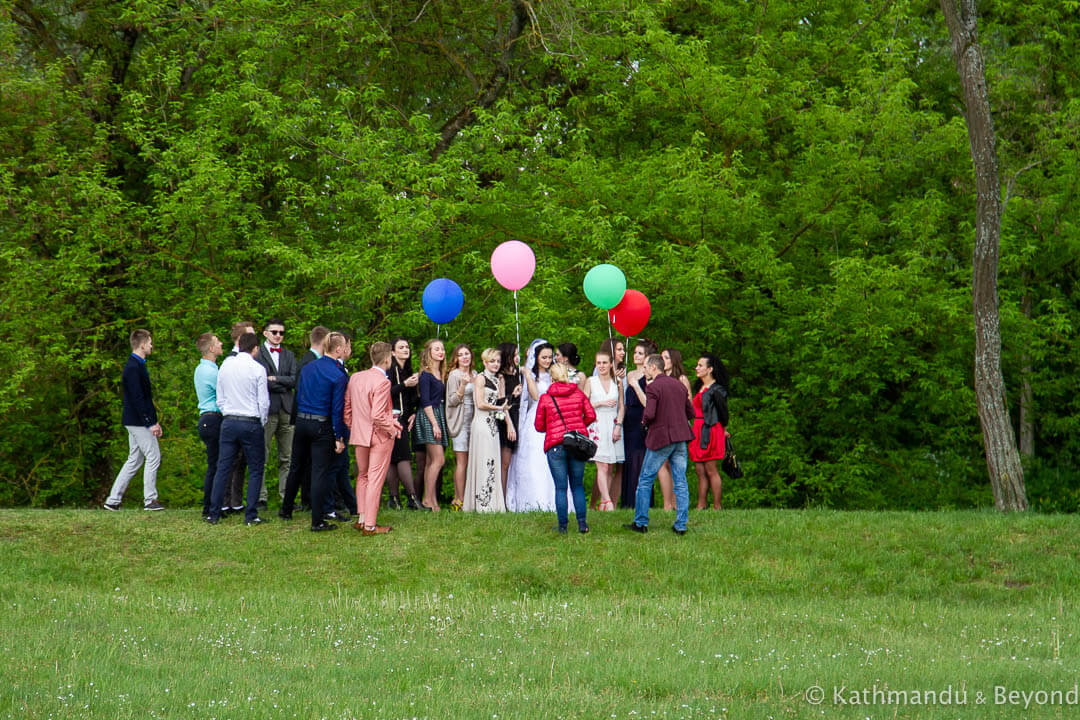
Where is Brest and how do you get to the fortress?
Brest is 350km southwest of the Belarusian capital, Minsk, and about 200km directly east of Warsaw in Poland. There are regular trains between Minsk and Brest, which take four hours, and getting to Warsaw is also straightforward. Firstly, you have to take a train across the Belarus/Polish border to Terespol and then change to another train that will take you to Warsaw.
Although the train between Brest and Terespol only takes 20 minutes, it is advisable to buy your ticket the day before and also turn up at least an hour ahead of schedule in order to pass through customs and immigration. There are regular trains from Terespol to Warsaw and the journey time is in the region of 1 hour, and 45 minutes.
There are also regular buses between Brest and Grodno (Hrodna), a city close to the Lithuanian border that is also worth visiting.
Getting to the fortress from the centre of Brest is easy. Either take the #17 bus from outside the Hotel Intourist or walk there one-way in about twenty-five minutes.
Is there an entrance fee to visit Brest Fortress?
There is no entrance fee to enter the fortress complex but you do have to pay to enter the museums. I can’t remember the exact amounts but it isn’t very much.
Is Brest Fortress worth visiting?
For us personally, the answer is 100% yes. Even if you aren’t especially interested in Soviet-era architecture and/or World War II history, it’s hard not to be excited by the vast scale of many of the monuments within the grounds.
The city of Brest itself, however, is nothing special in my opinion. Lonely Planet describes it as being a ‘prosperous and cosmopolitan border town’. Personally, I’m not convinced by this statement – the pedestrian thoroughfare (Savetskaya Street) is pleasant enough and a good place to get a drink and something to eat, but the centre has little else to offer.
Where to stay in Brest
We stayed at the Hotel Molodyozhnaya in a double room with a private bathroom. The room was a little bit pokey but apart from that, it was a good choice. It’s close to the railway station and pedestrianised Savetskaya Street and the staff spoke a little English and were friendly and polite. We paid US$28.00 per night, room only.
Further Reading
On Wikipedia, you will find more information about the fortress and its defence and the official Brest Fortress website, which is in English, is well presented and has some good information on it:
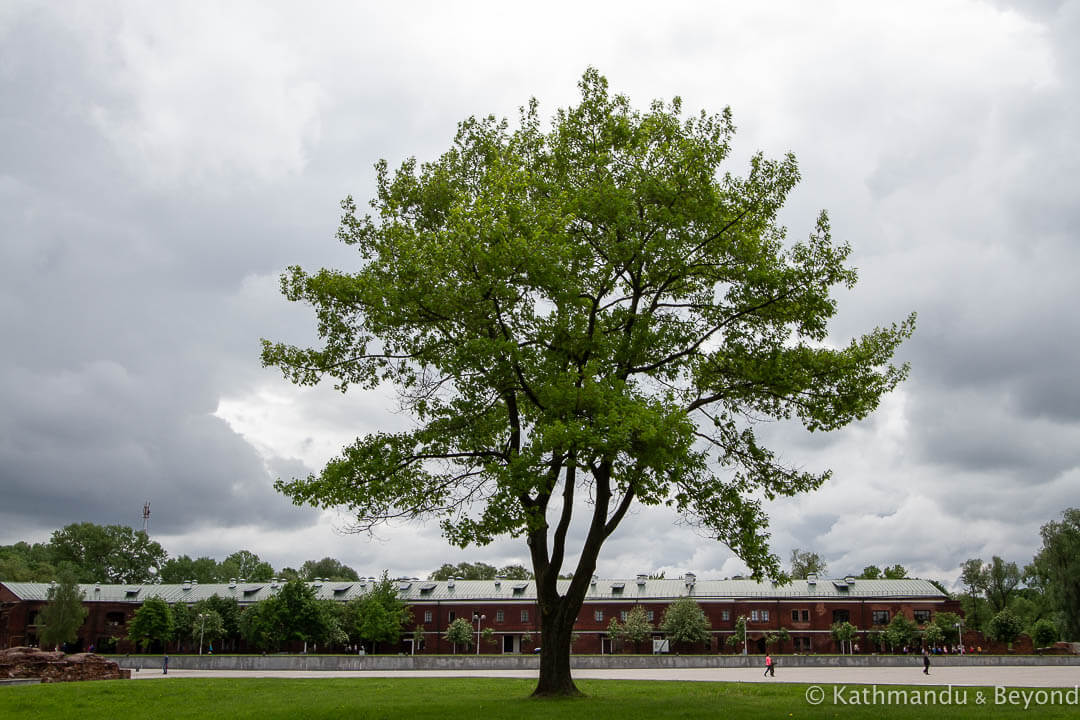
ARE YOU PLANNING A VISIT TO BREST FORTRESS? PIN IT FOR LATER …
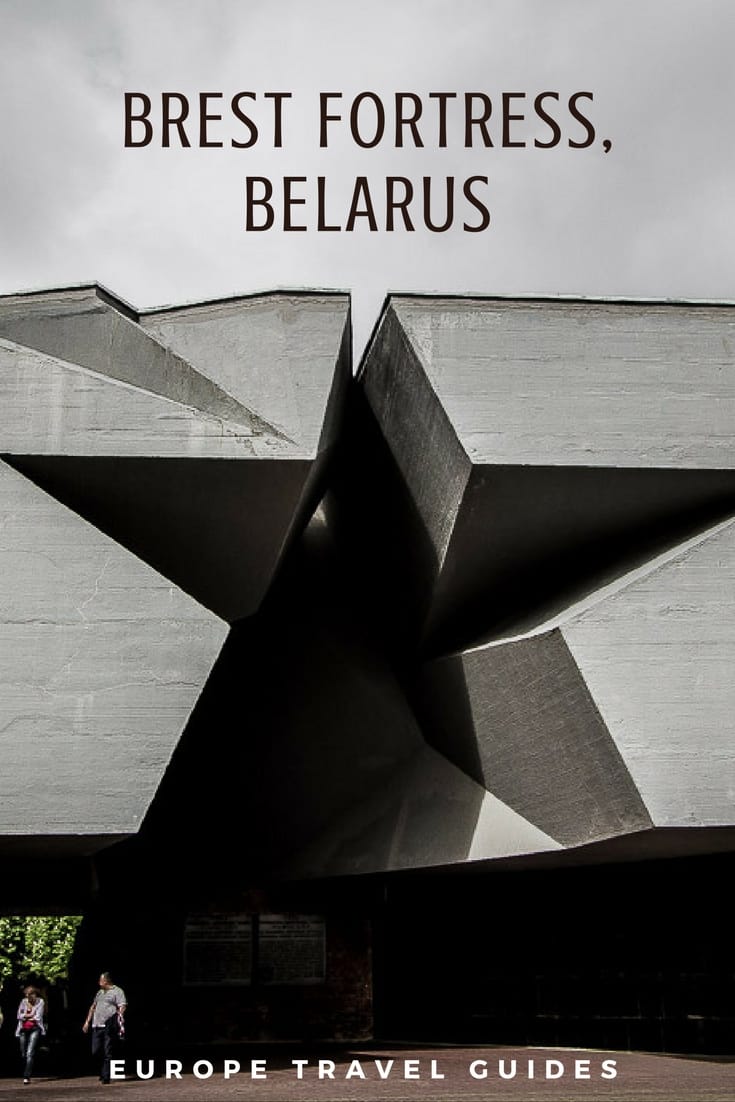
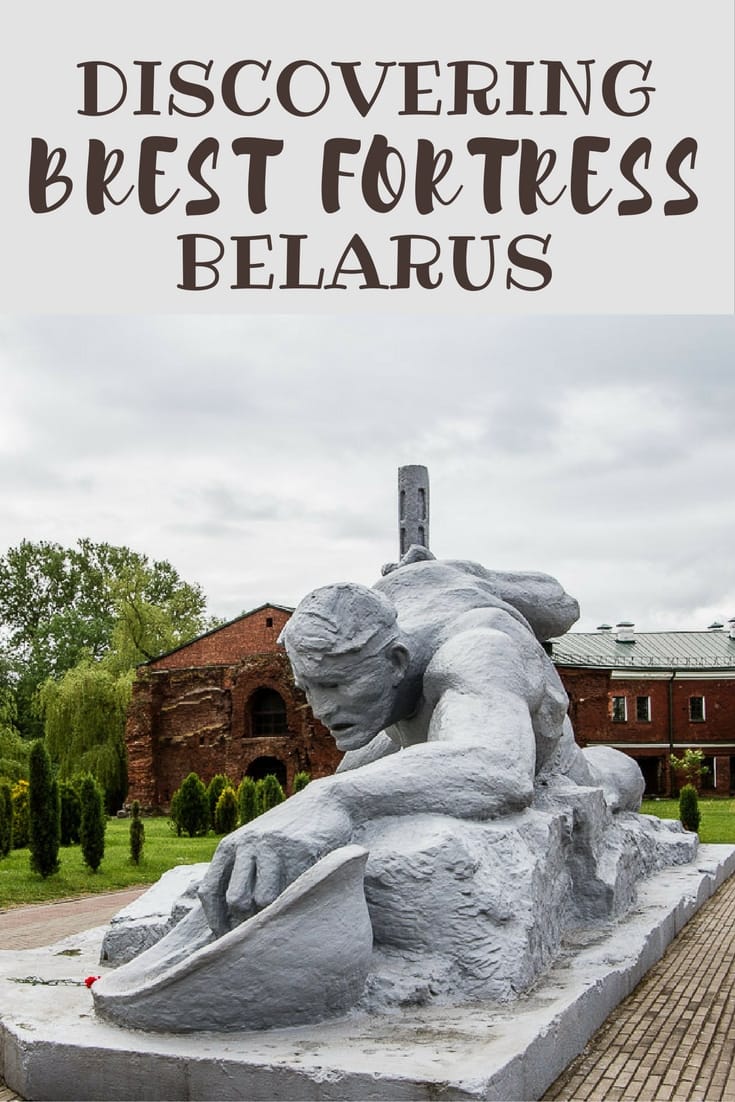

Your blog is always a good place to come when I start planning a trip 🙂 I definitely want to see this for myself, but sounds like Brest isn’t worth much more than a night (according to ‘the group’ also). You guys always like to go off the beaten path…do you have any recommendations for Belarus beyond Minsk, Brest and Grodno (no worries if not!)?
Unfortunately we haven’t been beyond Minsk, Brest and Grodno. I would agree that Brest only needs a full half day to see the fortress and perhaps the train museum. There is little else there. We only had half a day in Grodno but I suspect that wasn’t enough – it’s a nicer looking city than Brest and has a decent old town as well as plenty of Soviet stuff – I would plan a full day there if you can. We both really like Minsk – I recommend at least two full days – one for looking around the city centre and another to get out to the Mound of Glory and other places further afield. We haven’t done any of the classic day tripe ex Minsk – doing them on public transport was a pain and we don’t really do tours! But, if you get the chance, I would imagine they are worth doing.
We were in Minsk for Independence Day parade on 9th May. The big show had been CXD a few days before and so we didn’t get to see that but it was still good being there on that day. If you are thinking of May then you might want to plan around it??
We did enjoy crossing the border from Lithuanian – see Kaunas, Druskininkai and Grutus Park. You would have to get a visa in advance if you enter via this route though. We have an itinerary that covers it.
https://www.kathmanduandbeyond.com/vilnius-warsaw-via-belarus-itinerary/
That’s all I can tell you about Belarus – we need to go back!!
Definitely planning on flying in and out, rather than the extra hassle of a visa. However, it is cheaper to fly via Vilnius than direct, so likely to visit Kaunas or Druskininkai anyway (I visited Vilnius less than a year ago). I do public transport no tours as well…haven’t really drilled down that much yet, but I will amongst the reading that I’ll do! So much to read when you’re thinking about a while (big) country! 😀
Sounds like a good plan! I seem to spend half my time reading and researching places. One of the reasons we haven’t tackled Russia yet is because there is so much to research beforehand. I’ve got to get one with it one day though!!
While I would love to see Russia, there’s no way that I am giving money to a system that would merrily put me (or anyone!) to death for being queer. I’m simply not supporting that with my tourist money. So Russia is off the cards, and I should imagine will be for a long time to come!
Fair enough, the regime there certainly has plenty to answer for! There’s enough to see in world that means you don’t have to go anywhere you don’t want to – I will probably never go to Saudi Arabia for example because of my views.
Im not afraid of wagner or any similar.the stupidity of volks (those in tourisnegatction)bothers me.not listening to all were negative i came in bree t.not first time.terespot brest took me 15 hrs.arriving at 0300hrs(easy bug hotel with a room smaler than my tomb 45 e next day at hotel intourist.i can afford luxary of time(300 days)yearly.sudenly they told me u have to go tomorrow.this was
Sorry to hear about your troubles. Unfortunately, it is probably not the best time to travel in the region.